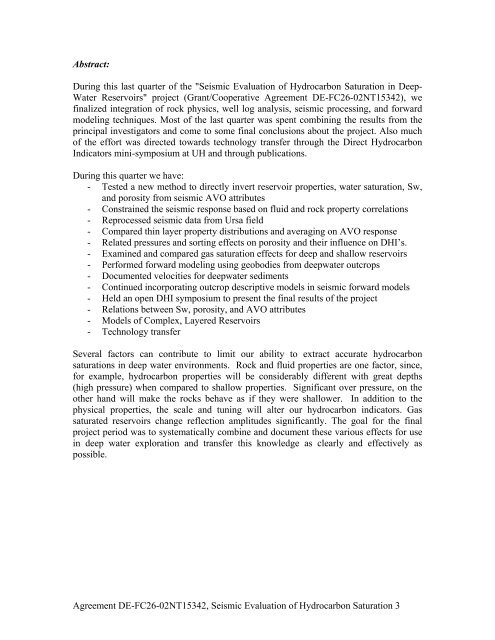Agreement DE-FC26-02NT15342, Seismic Evaluation of ...
Agreement DE-FC26-02NT15342, Seismic Evaluation of ...
Agreement DE-FC26-02NT15342, Seismic Evaluation of ...
You also want an ePaper? Increase the reach of your titles
YUMPU automatically turns print PDFs into web optimized ePapers that Google loves.
Abstract:<br />
During this last quarter <strong>of</strong> the "<strong>Seismic</strong> <strong>Evaluation</strong> <strong>of</strong> Hydrocarbon Saturation in Deep-<br />
Water Reservoirs" project (Grant/Cooperative <strong>Agreement</strong> <strong>DE</strong>-<strong>FC26</strong>-<strong>02NT15342</strong>), we<br />
finalized integration <strong>of</strong> rock physics, well log analysis, seismic processing, and forward<br />
modeling techniques. Most <strong>of</strong> the last quarter was spent combining the results from the<br />
principal investigators and come to some final conclusions about the project. Also much<br />
<strong>of</strong> the effort was directed towards technology transfer through the Direct Hydrocarbon<br />
Indicators mini-symposium at UH and through publications.<br />
During this quarter we have:<br />
- Tested a new method to directly invert reservoir properties, water saturation, Sw,<br />
and porosity from seismic AVO attributes<br />
- Constrained the seismic response based on fluid and rock property correlations<br />
- Reprocessed seismic data from Ursa field<br />
- Compared thin layer property distributions and averaging on AVO response<br />
- Related pressures and sorting effects on porosity and their influence on DHI’s.<br />
- Examined and compared gas saturation effects for deep and shallow reservoirs<br />
- Performed forward modeling using geobodies from deepwater outcrops<br />
- Documented velocities for deepwater sediments<br />
- Continued incorporating outcrop descriptive models in seismic forward models<br />
- Held an open DHI symposium to present the final results <strong>of</strong> the project<br />
- Relations between Sw, porosity, and AVO attributes<br />
- Models <strong>of</strong> Complex, Layered Reservoirs<br />
- Technology transfer<br />
Several factors can contribute to limit our ability to extract accurate hydrocarbon<br />
saturations in deep water environments. Rock and fluid properties are one factor, since,<br />
for example, hydrocarbon properties will be considerably different with great depths<br />
(high pressure) when compared to shallow properties. Significant over pressure, on the<br />
other hand will make the rocks behave as if they were shallower. In addition to the<br />
physical properties, the scale and tuning will alter our hydrocarbon indicators. Gas<br />
saturated reservoirs change reflection amplitudes significantly. The goal for the final<br />
project period was to systematically combine and document these various effects for use<br />
in deep water exploration and transfer this knowledge as clearly and effectively as<br />
possible.<br />
<strong>Agreement</strong> <strong>DE</strong>-<strong>FC26</strong>-<strong>02NT15342</strong>, <strong>Seismic</strong> <strong>Evaluation</strong> <strong>of</strong> Hydrocarbon Saturation 3
















